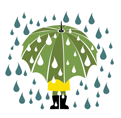Pandemic 101 – A Crash Course

Pandemic 101 – A Crash Course
This is a short and simple guide for you during this strange and scary time of the COVID-19 pandemic. Written by your friendly neighborhood therapist and anxiety specialist, Katie Raines, MA, LMHC.
Chapter One:
There is no playbook for this life we are living. That means you can’t do it “right” or “wrong” on a daily basis. You can simply do your best each day. I am hearing from my anxious mind that I am doing this wrong: I should be more, better, different, etc.
Tip 1: Live each day one-day-at-a-time right now. Get up. Do your best (which will vary from day to day.) Notice your day. Go to bed. Try again tomorrow. That is enough. That is plenty.
Chapter Two:
Your brain is very uncomfortable right now. Brains like to be in charge, have control, and be able to plan and maneuver constantly. Right now, they are unhappy. Think about how we used to make fun of our moms in the car for turning down the radio when looking for an unknown turn (and now we do it, too! Ugh.) Well, that is our brain all the time now. It’s having trouble functioning, because it’s too stimulated from the unknowns. Our brains hate uncertainty, but that’s what we have to deal with these days in a chronic way.
Tip 2: Be extra gentle and compassionate with yourself right now. Our brains need a lot of latitude right now. They are tired and not very sharp these days.
Chapter Three:
Because our brain is tired, our bodies get exhausted more easily. It is taking so much more energy to move though this world than it did only a couple of months ago. We’re sitting in daily fear about the world around us. Example: I have never in my life thought about germs on my groceries, but I am now decontaminating each load of my groceries. I’m nervous to go pick up my groceries. I’m thanking all of the people who help me with those groceries. I’m worried about the amount of money I’m paying for the groceries. I’m pondering the groceries that were unavailable. That ENTIRE thought process takes energy. That energy is taken from my physical body…and this example is just groceries, not parenting, work, family health, relationships, e-learning, etc. Feeling tired just reading this?
Tip 3: Rest. It’s fine to take naps and also go to bed early. Remember that every person you meet is also emotionally drained and physically tired. Let’s all get extra rest to keep us going right now. There’s no shame in my sleep game right now. None.
Chapter Four:
We are being slowly and chronically traumatized and anxiety is very high. We need to learn the difference between Actual Threat and Perceived Threat. Actual Threat means that there is a bear loose in your house, and it’s ready to eat your face off. Therefore, you are in a heightened state of arousal and ready to react (fight, flight, or freeze.) Perceived Threat mean that you’ve heard of many loose bears in other houses (not your own), but your body is responding like there’s one loose in your house. We are living in a time of constant stories about COVID-19. When we expose ourselves to the stories, we become physically and emotionally aroused by Perceived Threat. There is also Actual Threat in our lives when we do not use our best skills of social distancing, washing hands, etc.
Tip 4: Check in with yourself and your reality. Am I safe? Am I sitting at home doing my very best to stay safe and healthy? Am I taking all precautions to be wise during this time? If I’m going out, am I continuing to do my very best to stay safe and healthy? Most likely, you’re truly safe and secure. Exercise can really help with feeling present. Get outside when you can.
Tip 4 ½ : Please be balanced in your time spent watching the COVID-19 stories. Decide what you need to do to stay knowledgeable and create a boundary. Maybe you choose to only watch the local news for an hour in the evening, or you might decide to watch the daily national news conference. Get the information you want and then move on to anything else that keeps you in your present reality.
Chapter Five:
We are experiencing high levels of grief. There are losses all around us right now. We’ve lost physical safety, financial security, in-the-flesh relationships and connections, and our usual routines and rituals. Grief might feel like anger, irritability, fatigue, sadness, or impatience. There is a difference between grief and mourning. Grief is a noun. Mourning is a verb. We generally are now sitting in grief and just pushing through. We’re managing budgets, helping kids with e-learning, working from home. But we’re not making time to actually mourn.
Tip 5: Set aside mindful time for mourning and processing your feelings of loss. The rest of the day, utilize a thought-stopping process that creates boundaries as grief presses into your daily life. I say, “I choose to think about this later.” It isn’t avoidance. It’s strategy. Where do you mourn? In the shower or while taking a walk? Going for a drive and turning up the radio loud with the windows down? Screaming into a pillow? It’s okay to feel grief. It’s okay to mourn.
Chapter Six:
That’s all well and good but I’m still freaking out!
Tip 6: It’s absolutely okay to be overwhelmed and anxious. Let’s unclench and breathe. Take notice of your body: Begin by softening your forehead and scalp. Move down and unclench your cheeks and jaw. Loosen those shoulder muscles, allowing them to drop toward the floor. Relax your lower abdomen, allowing your core to expand without tension. Relax your groin area, sinking into your chair. Breathe in, counting to 4. Breathe out counting to 4. Continue to release and relax your body, breathing in and out mindfully.
Be well, dear sweet souls. Do your best. Remember, that’s plenty.


Recent Comments